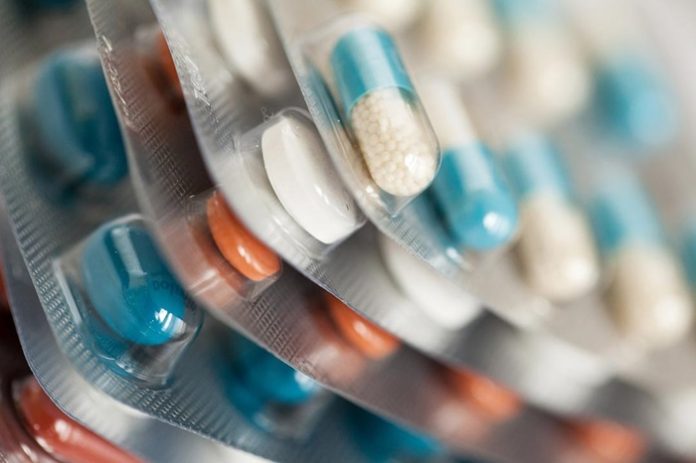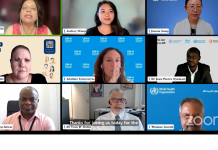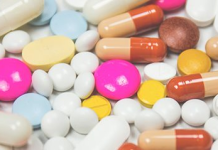“Antimicrobial Resistance (AMR) is invisible, but I am not. So, AMR can happen to anyone,” said Felix Liauw of Indonesia, a caregiver of his 3 months old son who passed away sadly after extensive misuse and overuse of medicines.
Felix is a member of World Health Organization (WHO) Task Force of AMR Survivors. “As a pediatrician and caregiver, I would like to share that we should give antibiotics or other antimicrobials only when we have a proper diagnosis. We should be aware of hospital-acquired infections and do all what we can to stop the transmission of infections.”
He added: “Right after birthing, my son had chronic diarrhea and fever. A doctor (wrongly) diagnosed him with sepsis. His sepsis-treatment changed from first-line antibiotics to second-line antibiotics to third-line ones (meropenem) but no improvement was there. After a genetic test, we learnt that my son had a rare genetic-mutation related condition, called congenital short bowel syndrome. Our child could not tolerate any kind of milk (breast milk or any infant formula feed). My son died after three months of being born.”
“Antimicrobial Resistance (AMR) occurs when bacteria, viruses, fungi and parasites no longer respond to antimicrobial medicines. As a result of drug resistance, antibiotics and other antimicrobial medicines become ineffective and infections become difficult or impossible to treat, increasing the risk of disease spread, severe illness, disability and death. AMR threatens our ability to treat common infections and to perform life-saving procedures including cancer chemotherapy and caesarean section, hip replacements, organ transplantation and other surgeries,” said Thomas Joseph, head, AMR Awareness, Campaigns and Advocacy, World Health Organization (WHO) HQ and Chairperson of AMR Awareness Working Group for the Quadripartite Joint Secretariat on AMR.
Misuse and overuse of antimicrobials; poor access to quality, affordable medicines, vaccines and diagnostics; lack of awareness and knowledge; population movement; lack of access to clean water, sanitation and hygiene; poor infection and disease prevention and control in healthcare facilities and farms, are the main drivers of AMR in human health sector, said Thomas, who was speaking at Global Media Forum around World AMR Awareness Week (WAAW) organised by Global AMR Media Alliance (GAMA).
There are different types of antimicrobials, like antibiotics which treat infections caused by bacteria but there are also antivirals which treat infections caused by viruses such as HIV for example, or antiparasitics which treat infections caused by parasites such as malaria for instance, and antifungals which are used to treat infections caused by fungi such as yeast infections.
“Data shows that there were 1.27 million attributable deaths directly caused by bacterial AMR in 2019 but the number of total associated deaths to AMR in a year is around 5 million. AMR deaths may increase by 50% in the next 25 years,” said WHO’s Thomas Joseph.
AMR and substandard and falsified medicines
“AMR really risks reversing some of the gains that we have made in modern medicine. In addition, AMR also places a heavy burden on health systems and jeopardize our response to dealing with health emergencies such as pandemics. Using the wrong treatment can result in lack of cure and negative patient outcomes. This is further compounded by the problem of substandard and falsified medicines which are widely prevalent especially in low and middle- income countries. Substandard and falsified medicine is a form of misuse that is often invisible to the provider,” said Alexandra Cameron, Unit Head, Impact Initiatives and Research Coordination, Antimicrobial Resistance Division, WHO.
“Overuse of antimicrobials can also lead to medicine stockouts making effective treatments unavailable to other patients who desperately need them and when stockouts of antimicrobials occur, we have provider surveys that show us that providers are often forced to use either suboptimal treatments, so looking at alternative suboptimal treatments, or treatments that are much more expensive than what would be the first line of therapy,” added Alexandra of WHO. “We also have the paradox that misuse and overuse of antimicrobial medicines coexists alongside a lack of access to effective antimicrobials. In low and middle-income countries, lack of access is causing more deaths than AMR itself.”
UNGA HLM on AMR 2024 Political Declaration
World leaders endorsed a strong political declaration at the 2024 United Nations General Assembly High-Level Meeting on AMR (UNHLM on AMR). Reducing the global deaths associated with AMR by 10% by 2030 against the 2019 baseline of 4.95 million deaths is one of the targets. 100% of countries having basic water, sanitation, hygiene and waste services in all healthcare facilities and 90% of countries meeting all WHO minimum requirements for infection prevention and control programmes at the national level by 2030 are a couple of other targets to which world leaders have committed. Another important UNHLM on AMR target is that at least 80% of countries can test drug-resistance in all bacterial and fungal pathogens by 2030.
AMR in food and agriculture sector
“AMR is a One Health issue because it represents the growing challenge to the agriculture and food sector with serious consequences for animal health, food safety and also global food security,” said Yu Qiu, Animal Health Officer, FAO Food and Agriculture Organization of the United Nations (FAO). “In context of animal health, AMR undermines the effectiveness of antimicrobial drugs used to treat infections in livestock and companion animals and those treatment have become less effective. More and more animals are suffering from the difficulty to get timely diagnosis and treatment against the infectious diseases, so they are also suffering from higher mortality rates and reduced productivity.”
The World Bank projects that in a high AMR impact scenario the livestock production in low- and low-income countries could decline by 11% until 2050. This could pose a significant challenge to food safety and livelihood of farmers whose income are mostly relying on food producing animals for their household, said Yu Qiu.
“AMR poses a significant threat to food security. Resistant microorganisms like bacteria in animals could spread through the food supply chain contaminating meat dairy products, eggs and other animal products, and eventually the food chain. This could increase the risk of food-borne diseases and infections. Infections caused by these drug-resistant bacteria are also harder to be treated in the human populations,” added Qiu.
AMR and environment
“Global attention to AMR has mainly focused on human health, animal health and agriculture sectors, but there is growing evidence that the environment plays a key role in the development, transmission and spread of AMR. Increased use and misuse of antimicrobials and other microbial stressors, such as pollution, create favourable conditions for microorganisms to develop resistance both in humans and the environment from sources such as sewage,” said Wondwosen Asnake Kibret, Policy and Partnerships Coordinator, United Nations Environment Programme (UNEP).
“The environmental dimensions of AMR include pollution from hospital and community wastewater, effluent from pharmaceutical production, run-off originating from plant and animal agriculture and other forms of waste and releases. These matrices may contain not only resistant microorganisms, but also antimicrobials, various pharmaceuticals, microplastics, metals and other chemicals, which all increase the risk of AMR in the environment,” said Wondwosen Asnake Kibret of UNEP.
“Polluted waterways, particularly those that have been polluted for some time, are likely to harbour microorganisms that increase AMR development and distribution in the environment. With increasing pollution and lack of management of sources of pollution, combined with AMR in clinical and hospital settings and agriculture, risks are increasing,” he added.
The key economic-sectors contributing to the environmental dimensions of AMR can be broadly classified as: pharmaceutical and other chemical manufacturing and uses including a range of different chemicals, such as antibiotics, antivirals and fungicides as well as disinfectants; agriculture including animal production, aquaculture, food crops or those providing inputs such as feed, textiles, ornamental plants, biofuels and other agricultural commodities; healthcare delivery in hospitals, medical facilities, community healthcare facilities and in pharmacies where a broad range of chemicals and disinfectants may be used.
UN Environment Programme Report “Bracing for superbugs: Strengthening environmental action in the One Health response to antimicrobial resistance” calls for priority action to address key pollution sources from poor sanitation, sewage; community and municipal wastes; healthcare delivery; pharmaceutical manufacturing; intensive crop, and terrestrial and aquatic animal production sectors.
Using the ‘One Health’ approach, which recognises that the health of people, animals, plants and the environment are closely linked and interdependent, can successfully address AMR, said Wondwosen of UNEP. Prevention is at the core of the action and environment is a key part of the solution.
Animal health and AMR
“Emergence of antimicrobial resistance makes it much more difficult to treat common infections and diseases in animals. Untimely mortality and morbidity in animals due to AMR is having a serious impact on animal health and welfare sector – not only on food producing animals but also for companion animals that have a very close contact with humans,” said Ana Luisa Pereira Mateus, scientific coordinator from the Antimicrobial Resistance and Veterinary Products Department, World Organisation for Animal Health (WOAH).
“AMR has an adverse impact on livelihoods of those who depend on food producing animals because of decreasing productivity. AMR also impacts local economies. Up to one in five people in the world depend on food producing animals to secure their livelihoods. Findings of the “Forecasting the Fallout from AMR: Economic Impacts of Antimicrobial Resistance in Food-Producing Animals” Report of World Organisation for Animal Health (WOAH) and partners, underscore the severe threat caused by AMR if no action is taken. Forecasts for 2025–2050 show that 38.5 million human deaths will be associated with bacterial AMR. Moreover, the global healthcare costs of AMR could rise to US$ 159 billion a year by 2050. In the animal sector, cumulative global gross domestic product (GDP) loss due to AMR in livestock is predicted to be US$ 575 billion by 2050,” said Ana Luisa of WOAH.
Data are sparse on the topic of antimicrobial use and resistance, particularly from low- and middle-income countries. This gap is even wider in the animal health sector. Underpinning this lack of data that would help generate evidence are weak information systems; this is partly due to inadequate financial resources to support such systems that could synthesise evidence across sectors.
“In particular, the animal health sector requires adequate support to accelerate the response to the growing threat of AMR. Antimicrobials are critical medicines, and their effectiveness must be preserved for the treatment, control and prevention of infectious diseases in animals, humans and plants when needed,” added Ana Luisa of WOAH.
Young people want a future where AMR is no longer a threat
“AMR necessitates a multisectoral and interdisciplinary well-coordinated effort to address the challenges it poses. AMR warrants a whole of society approach to address it. Youth represent a significant part of our population, and we must be meaningfully engaged in AMR responses. The political declaration adapted by world leaders at the 79th UN General Assembly High Level Meeting on AMR holds many opportunities for youth to strengthen and advance the commitments from countries,” said Augusto Baron, Quadripartite Working Group for Youth Engagement on AMR.
“Role of youth is crucial as key stakeholders in achieving joint action against AMR. Empowering the next generation through effective communication is not just a necessity but a powerful tool to inspire learning, advocacy, and action,” Augusto added.
“First, we need to end inequity and injustice in health responses. We must ensure best of diagnostic tools are available for all diseases and infections to everyone – especially those who are most likely to be unreached by existing public services. Linkage to effective treatment and care is critical without any delay. Access to health must be people-centered, rights-based and gender transformative. Infection control in healthcare settings, communities and homes must be ensured. Vaccination saves lives so why are people dealing with vaccine-preventable illnesses? Failure is not a choice when it comes to challenges like AMR. We must ensure health security for everyone with equity and justice,” said Shobha Shukla, Chairperson of Global AMR Media Alliance (GAMA).
Global AMR Media Alliance (GAMA), WHO Task Force of AMR Survivors, and Quadripartite Working Group on Youth Engagement for AMR were among those who were awarded the prestigious “AMR One Health Emerging Leaders and Outstanding Talents Awards” at 4th Global High-Level Ministerial Conference on AMR that concluded last weekend.









